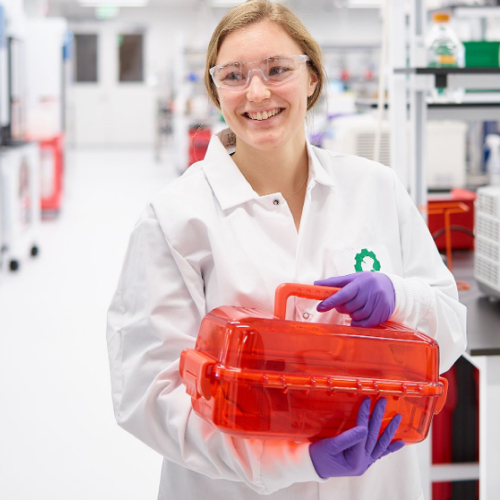Project Update: Read about our progress on this project here!
Our mission is to make biology easier to engineer—that hasn’t changed for the ten years we’ve been building Ginkgo. The ability to read, write, and design DNA code is having profound positive impacts in medicine, agriculture, and manufacturing, from engineered cell therapies that can target a person’s cancer cells, to probiotics for plants that can reduce the need for nitrogen fertilizers, to sustainably grown materials.
We are working to unlock the enormous power of biology: its ability to grow sustainably, to process information, and adapt to changing environments. But we’re not naive to the potential risks. We understand that as it becomes easier to engineer biology, it will become easier to engineer the part of biology that’s dangerous to humans, animals, and plants—the pathogens and parasites that can infect us. Since researchers synthesized the polio virus in 2002, it has been technically possible to chemically synthesize viruses that infect humans
To date, the work done on synthesizing viruses has been intended for medical research and other peaceful purposes, but there is a concern that someone could theoretically produce a virus or other pathogen with the intent to harm. The intentional use of pathogens to harm others is abhorrent and something that I believe that we should never do under any circumstances—as a company and as human beings. The international community agrees with me on this: 180 countries including the United States are parties to the UN Biological Weapons Convention, which was first signed in 1972 and states that we are “never in any circumstance to develop, produce, stockpile, or otherwise acquire or retain: Microbial or other biological agents, or toxins…that have no justification for prophylactic, protective or other peaceful purposes.”
As the technology for synthesizing DNA code improves, groups from governments, industry, academia, and civil society have been developing frameworks for monitoring and assessing the safety and security of these new technologies. For example, we are a part of the international gene synthesis consortium, which developed standards for screening orders made to DNA synthesis companies. Our Head of Design, Patrick Boyle, was also recently on a panel convened by the National Academies of Sciences, Engineering, and Medicine to assess the risks of intentional misuse of synthetic biology.
Today we’re announcing Ginkgo’s biosecurity initiative that directly addresses some of these potential threats from engineered DNA sequences. Our current work on biosecurity focuses primarily on detecting potential threats using software that analyzes DNA sequences.
As part of IARPA’s (the Intelligence Advanced Research Projects Activity) Fun GCAT program, we are developing software to monitor DNA synthesis. This software is intended to ensure that no one orders DNA sequences that could have a pathogenic function. Think of this like a malware detector in computer programming—“programs” being written in synthetic DNA will go through the detector software, which will flag any sequences of concern before they are synthesized. The custom software we’ve developed for designing DNA sequences in our foundries is a useful start for a project like this—we need to be able to predict the function of enzymes based on their sequences in order to design new functions in our engineered microbes. Rather than predicting if an enzyme sequence could be used to produce, say, a fragrance or vitamin, here we’re applying the same types of algorithms to predict whether a given bit of code could be potentially harmful.
Unlike computer viruses, however, new biological viruses can also evolve in the wild. When a new virus emerges, researchers quickly sequence it to understand where it came from and how to best treat it and develop vaccines against it. We’re addressing this as part of another software-based biosecurity initiative, IARPA’s Finding Engineered Linked Indicators (FELIX) program. Here we are using deep learning to identify if the sequence of a new pathogen developed naturally or was engineered by humans. We’re leveraging our experience engineering the world’s largest library of engineered DNA sequences to help us train the software to detect whether something has been engineered.
Beyond developing software to guide the detection of threats, synthetic biology can also be important for responding to emerging diseases, for example making rapid response vaccines. It’s been almost a decade since the Venter institute partnered with Novartis on rapid synthetic DNA based vaccine development and the technology has been exponentially improving since then. Working alongside other companies, universities, and government agencies, we’re excited to be part of groups involved in developing tools to prevent, diagnose, and treat current and emerging diseases.
Ginkgo is the leading developer of genetic engineering tools we have an obligation to ensure that these tools are responsibly used. We are inspired by the words of Andy Weber, the former Assistant Secretary of Defense for Nuclear, Chemical & Biological Defense Programs under President Obama and a valued advisor to us here at Ginkgo on issues of biosecurity: we believe that while synthetic biology may lead to new risks, that these new tools also actually “offer the opportunity to take the global threat of biological weapons off the table.” By helping to develop software that can detect any threats before they materialize and develop the tools that can rapidly respond to emerging infectious diseases—natural or engineered—we hope to continue to drive the responsible growth of synthetic biology and realize its enormous potential for good.
For more on this story, check out Rebecca Spalding’s article in Bloomberg: “The DNA Cops Who Make Sure the World’s Deadliest Viruses Aren’t Rebuilt.“
